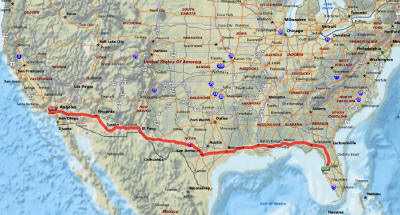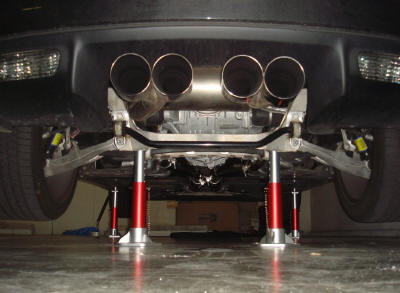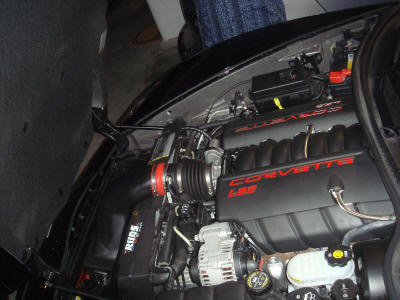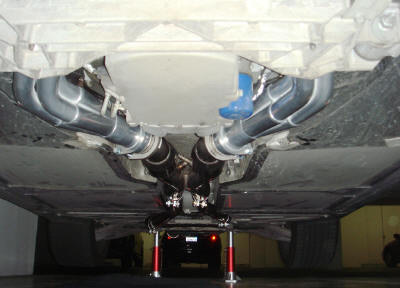Sam’s Corvette
The Car:
 I still remember the first time I saw the new Chevrolet Corvette C6 (6 stands for “6th generation”: Corvettes have been made since 1953): Some guy was driving one on the freeway outside Chicago and I stared at it, trying to figure out what the hell that was; it looked exotic, like an Italian sportscar, and I could tell just by looking at it that it was fast. And expensive. I never thought I would be able to afford one, at least not any time soon I was still glad they existed.
I still remember the first time I saw the new Chevrolet Corvette C6 (6 stands for “6th generation”: Corvettes have been made since 1953): Some guy was driving one on the freeway outside Chicago and I stared at it, trying to figure out what the hell that was; it looked exotic, like an Italian sportscar, and I could tell just by looking at it that it was fast. And expensive. I never thought I would be able to afford one, at least not any time soon I was still glad they existed.
Fast forward to 2 years later: the C6 had been out for a while, I was driving an older Corvette Z06 and thanks to depreciation and the fact that most people aren’t looking for a rear wheel drive sports car in the middle of winter, they were now more affordable than ever. Even while driving the best GM had to offer in 2003; the 50th Anniversary Z06, I still lusted after the C6; the much nicer interior, the HID projector headlights, the sleeker body, the nicer lines, larger brakes, better seats, higher top speed… But if I was going to do this, it had to be just right: I wouldn’t settle for just any C6.
 I found my dream car on an Ebay auction. It was everything I wanted it to be: Black, low miles (9000 at the time), immaculate, and with all the options I wanted: 2LT for the 6 way adjustable power seats and side airbags, and the all important Z-51 Sport/Handling package, with its larger brake rotors, shorter gear ratios, stiffer shocks and springs, larger sway bars, grippier Goodyear Eagle F1 Supercar tires and engine, transmission and power steering oil coolers. The previous owner even threw in a billet aluminum dead pedal, covering up the ugly factory plastic piece, and put a Z06 rear spoiler in place of the almost non existent factory one.
I found my dream car on an Ebay auction. It was everything I wanted it to be: Black, low miles (9000 at the time), immaculate, and with all the options I wanted: 2LT for the 6 way adjustable power seats and side airbags, and the all important Z-51 Sport/Handling package, with its larger brake rotors, shorter gear ratios, stiffer shocks and springs, larger sway bars, grippier Goodyear Eagle F1 Supercar tires and engine, transmission and power steering oil coolers. The previous owner even threw in a billet aluminum dead pedal, covering up the ugly factory plastic piece, and put a Z06 rear spoiler in place of the almost non existent factory one.
And, if I could sell my Z06, I might just be able to afford it.
I bought it on a Thursday sitting in my living room in Los Angeles, California, while browsing Ebay. Friday night I had arrived in Tampa Florida to inspect the car and take it away. I drove from Tampa to San Antonio on Saturday, then from San Antonio to Los Angeles on Sunday, just in time to get to work Monday.
2600 miles across the country, in two days. During that time I was able to make the following observations:
– This car is incredibly comfortable to drive for extended periods of time. After adjusting the 6 way power seats just the way I wanted I could sit there and just drive for hours and hours on end… It is perfect!
– High Intensity Discharge (HID) Projector headlights are amazing! The beam pattern is a perfect white rectangle right on the road and the high beams go on for miles. I feel as comfortable driving it at night, as I did during the day.
– When you drive a new Corvette, people want to see who is driving it. When your windows are tinted, they can’t 🙂
– This car is FAST. But not quite as fast as my Z06. I would fix that soon enough…
Making a Supercar:
 There are many ways of making a car faster, but adding horsepower is the surest one (adding 200HP is a lot easier than, say, removing 800lbs of weight from a car:). Of the tried and proven ways of adding horsepower to an engine, it always comes down to one thing: increasing the amount of airflow through the engine.
There are many ways of making a car faster, but adding horsepower is the surest one (adding 200HP is a lot easier than, say, removing 800lbs of weight from a car:). Of the tried and proven ways of adding horsepower to an engine, it always comes down to one thing: increasing the amount of airflow through the engine.
And what better way to do that than by Supercharging it?
The decision was not an easy one; many would argue that, at 400horsepower/400ft-lbs torque, the stock 6Litre V8 engine was more than adequate for a 3140lbs car… Already I was making around 450hp via a cold air intake, long tube headers, high flow catalytic converters and an ECU retune… The next logical step was to dig in to the engine and pursue even more volumetric efficiency: ported heads, and a camshaft; this combo will net around 500hp with a mild cam; more than that and the drawbacks of a high lift/high overlap cam really start manifesting themselves; lope at idle, poor fuel economy, surging at low RPMs. Still 500HP should be plenty. The only problem is I couldn’t do the install for that myself, so all in all the cost would end up being as much or more than a supercharger
 At 10.9 : 1 the LS2 engine is an unlikely candidate for forced induction… Still, many have done it and with some very high (800+) examples running after 30thousand miles or more, I stopped worrying. After extensive research I decided that the A&A Performance kit with a Vortec V2 Si-Trim SQ blower was right for my needs. The Si-Trim is the most efficient Centrifugal supercharger made in this size, rated at 55000RPM and flowing 1150CFM at 78% Thermal efficiency. Vortec claims it is good for 22PSI and 775HP!
At 10.9 : 1 the LS2 engine is an unlikely candidate for forced induction… Still, many have done it and with some very high (800+) examples running after 30thousand miles or more, I stopped worrying. After extensive research I decided that the A&A Performance kit with a Vortec V2 Si-Trim SQ blower was right for my needs. The Si-Trim is the most efficient Centrifugal supercharger made in this size, rated at 55000RPM and flowing 1150CFM at 78% Thermal efficiency. Vortec claims it is good for 22PSI and 775HP!
A&A’s kit arrived with everything I needed to supercharge the car, down to the spark plugs. The install was lengthy for a first timer; about 30 hours in all, and I ended up doing it over the weekend and Monday in a rented garage, which happened to be be unlit, extremely warm, and leaked tons of water through the roof, as there was a hurricane at the time. Still, on the 3rd day, the car fired right up and I carefully drove it to the tuner to have it tuned (results on bottom of page)
You can think of a centrifugal supercharger as a belt driven turbo; in this particular example, the compressor is driven by a 3.60:1 reduction gearbox, which itself is driven by a 2:1 pulley ratio; consequently, the impeller is always turning at 7.2 times the engine speed. Unlike a turbo, boost is made instantly; the moment the gas pedal goes down, a bypass valve closes and the manifold pressurizes. Boost rises almost linearly with RPM, so for this particular combo there are 10PSI available at 6500RPM, but only 3PSI by 3250; power gains start out modest and climb steadily as the revs rise.
Supporting Modifications:
One could easily argue that Corvettes have not needed any additional horsepower since the Z06 came out in 2002. A bone stock C6 will do triple the speed limit of most American roads, and will out accelerate anything non exotic you are likely to find on a public road. Still, much like one can never have too much money… You also can’t ever have too much power 🙂 Plus, two things bothered me about my C6’s horsepower: First and foremost, as much as I hated to admit it, the Z06 was slightly faster. It weighted less (by about 80lbs) and did make slightly more power.
Secondly, in 2008 Chevrolet introduced the 6.2L LS3 engine to the Corvette lineup, so my Z51 LS2 was no longer the “king of the hill”; 2008 Corvettes came from the factory with 430HP.
It was time to inject a dose of “fun” on my car… I knew from my previous experiences with highly modified cars that I didn’t want to do anything too drastic; this car is still under full factory warranty, and I know how easy it is to start breaking stuff once you go for big power. Besides, even at 400HP the C6 is already struggling for traction at low speeds; making huge power on it will turn it into a burnout machine that is pointless and dangerous to drive in the streets.
Still, if the LS3 cars can handle 430, I figured I could be driving at *least* 450. It was time to improve volumetric efficiency…
When I bought the car it came with a GHL quad tip exhaust. It sounds nice, although like all other Corvette exhausts there is some drone around 1700RPM. Axleback exhausts will gain approximately 6HP on a stock corvette.
My first modification was a Vararam Cold Air Intake. The factory LS2 intake is not very restrictive, but it does pull air from the engine bay, and as the engine heats that air up, it becomes less dense, providing less oxygen per volume for combustion, resulting in power loss. The Vararam CAI solves that problem, along with improving airflow through a less restrictive filter. It is also a forward facing intake, which supposedly “rams” air into the engine at speed. I am not sure how significant this effect is, but the manufacturer claims it is substantial.
This made the car noticeably faster. Now it was time for something more drastic…
Factory cars all utilize a short, cast iron exhaust manifold that forces the exhaust gases to take 90 degree bends into a small opening into a large catalytic converter. This is good for emissions, but not for power. Good gains can be had by switching to an equal length, long tube header with a smooth 4-into-1 merge collector. I chose Kooks 1 3/4, and had them JetHot ceramic coated for heat retention, helping keep the engine bay cool and improving exhaust gas velocity. I also replaced the factory catalytic converters with two high flow units, and the factory “H” pipe with a nice 3″ diameter cross pipe. The results were incredible.
My car now sounds like an exotic race car, and the power gains were very noticeable. Now I just needed to tune it.
Brakes, Tires, and Handling:
 With great power comes great traction problems; trying to put down full throttle on this car with street tires in 1st and second gear became a real exercise in driver skill and careful pedal modulation; on a cold day, I found that I could gradually roll into the throttle in 3rd gear, and have the tires spin uncontrollably at 80 miles an hour!
With great power comes great traction problems; trying to put down full throttle on this car with street tires in 1st and second gear became a real exercise in driver skill and careful pedal modulation; on a cold day, I found that I could gradually roll into the throttle in 3rd gear, and have the tires spin uncontrollably at 80 miles an hour!
As mentioned before, this car comes with the Z51 Performance and Handling package; this already includes stiffer shocks and springs, and larger swaybars, making it possible for the car to sustain a cornering load of 0.98″G” on the skidpad, despite its stiff run-flat tires. For braking, the Z-51 employs 2-piston sliding calipers in front, and 1-piston sliding calipers in the rear. The front rotors are a massive 13.4″ diameter, whilst the rears are 13″ diameter. Both rotors are cross drilled and both the front and rear setup have cooling ducts.
For looks, I had my calipers powdercoated in glossy red; I liked that about the Z06 and the bare metal of the stock units didn’t do their size justice; I wanted them to stand out more..
The Z51 package tires are Goodyear Eagle F1 Supercar EMT, sized 245 40 18 up front, 285 35 19 in the rear. They are really good for being run flats, and the idea that I can drive 100 miles with a huge hole in my tire is nice. The trade off is that their steel belted sidewalls are extremely stiff, resulting in a tire that is noisy, rides harshly, and can’t really compare with the grip and traction of a non run flat. This is one of the main reasons why even the C6 Z06 (which also rides on run flats) can’t match the C5 Z06’s awesome 1.03G skidpad results. I will probably go with non run flats once these are bald. They are a soft compound tire, so they typically last less than 20K miles.
Interior:
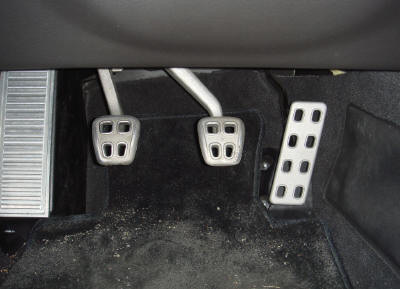 The C6’s interior is leaps and bounds better than my C5; you carry a key with an RF transmitter; this key unlocks the doors as you approach, allowing a recessed button to open them on touch. The engine is started not with a key, but with a glowing green “start” button that is also enabled by the transmitter’s presence. When you walk away the doors lock automatically.
The C6’s interior is leaps and bounds better than my C5; you carry a key with an RF transmitter; this key unlocks the doors as you approach, allowing a recessed button to open them on touch. The engine is started not with a key, but with a glowing green “start” button that is also enabled by the transmitter’s presence. When you walk away the doors lock automatically.
The LT2 package perforated leather 6 way power seats with side airbags and adjustable bolsters are excellent, as is the general fit and finish of the interior.
I did, however, have two big complaints:
1- The factory gas pedal was a ridiculous little slab of plastic . The dead pedal was also just a plastic spot next to the clutch. I replaced the gas pedal for the nice billet aluminum unit you see pictured here. The replacement involved removing a dowel pin with a C clamp and a socket, and then reversing the process to install it. Very easy, and very worth it.
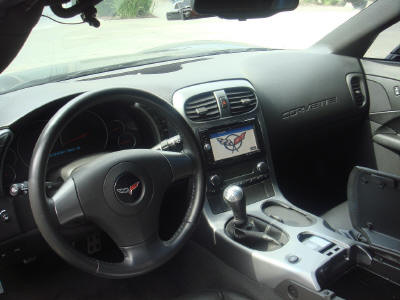 2- The factory Bose Stereo wasn’t anything to write home about. I installed a Pioneer AVCS-D3 DVD / Navigation / Satellite Radio / Bluetooth setup.
2- The factory Bose Stereo wasn’t anything to write home about. I installed a Pioneer AVCS-D3 DVD / Navigation / Satellite Radio / Bluetooth setup.
You can see the microphone for the bluetooth cell phone integration unit on the top left hand corner of the picture. In front of the center console I removed the cover that normally hides an 8GB Ipod Nano to show where it is installed. The nano holds all the songs I normally listen to. Also note the Valentine V1 radar detector hardwired behind my rear view mirror.
Power:
X
ECU Tuning:
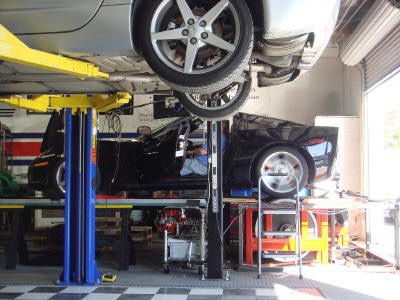 Corvettes utilize very advanced engine management, and the factory car is already at a fairly good state of tune. Still, factory calibrations are universal and have to contend with hundreds of thousands of cars that each have hundreds of sensors, any of which can display abnormalities or deviate from its intended accuracy over the lifetime of the vehicle. They also have to contend with varying weather conditions, atmospheric pressure, temperature, humidity, gas quality, consumers who put the wrong kind of fuel in, people who do not maintain their car properly, etc.
Corvettes utilize very advanced engine management, and the factory car is already at a fairly good state of tune. Still, factory calibrations are universal and have to contend with hundreds of thousands of cars that each have hundreds of sensors, any of which can display abnormalities or deviate from its intended accuracy over the lifetime of the vehicle. They also have to contend with varying weather conditions, atmospheric pressure, temperature, humidity, gas quality, consumers who put the wrong kind of fuel in, people who do not maintain their car properly, etc.
And they have to do this while still passing emissions AND not breaking the car during GM’s 5 year / 100,000 mile warranty. As a result, the factory tune does leave some power on the table so as to err in the side of caution. Start modifying the car, and even though it may continue to run normal and may even gain power, fueling and ignition timing parameters will no longer be optimal. To extract the most power out of any modification every car need a tune.
I had my car tuned at RPM Motors in Valencia, CA (about a 2 hour drive for me).
 The tuner, Charlie spent almost 3 hours tuning my car; He ran full throttle, open loop runs on the dyno until the engine was running completely smooth and everything was just perfect. Then he did closed loop tuning for part throttle, throttle transitions, decel, etc. Then he took it out on the road and datalogged it for some real world data.
The tuner, Charlie spent almost 3 hours tuning my car; He ran full throttle, open loop runs on the dyno until the engine was running completely smooth and everything was just perfect. Then he did closed loop tuning for part throttle, throttle transitions, decel, etc. Then he took it out on the road and datalogged it for some real world data.
The final result:
I asked for a really mild, safe, 91 octane daily driven street tune, and specifically told Charlie that I was more than happy giving up those last couple HP for an engine that I could take to the track on a hot day and drive as hard as I want without worrying about it detonating. Charlie delivered, and his tune made precisely the amount of power he predicted it would.
RPM Motors utilizes “HP Tuner”, which is a popular (and very capable!) OBD-2 reflash interface for Chevrolet vehicles.
Results:
The dyno used for tuning was a DYNOmite eddy current brake dyno. It consists of a 3500lbs roller with an eddy current brake that allows load to be placed anywhere in the RPM band. A factory LS2 typically dynos 340hp / 340torque on this type of dyno (60hp are lost in the transmission and differential before power gets to the ground).
For those of you wondering “is it worth getting my car tuned”? Here is what I found:
The baseline was 364hp / 361.6tq at the wheels on RPMs Dynomite eddy current braked roller dyno. I.E. Headers/X-Pipe + CAI + Exhaust netted me a gain of 24horsepower and 22 torque. That’s a 24hp gain for about 2 grand worth of mods. It sounded nice, and it was faster, but that’s quite short of my goal of making more power than an LS3 in a bolt ons LS2.
Here is what I ended up with post-tune:
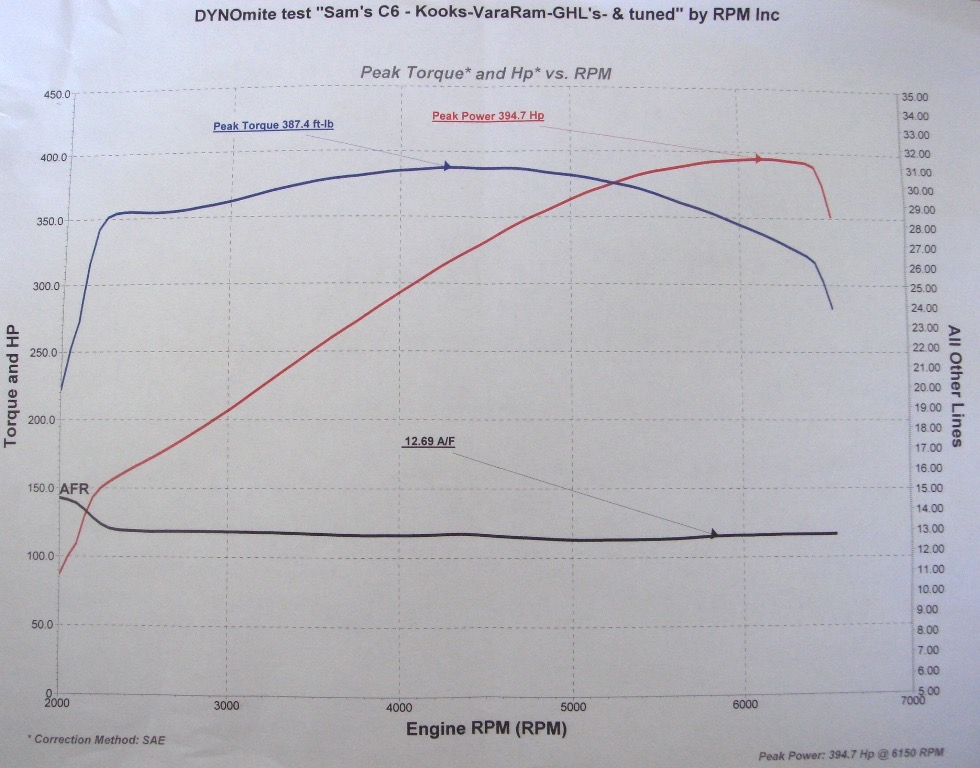
This run was done at 84F with the engine at 200+F. The car now makes almos 400HP at the wheels. That’s approximately 465HP at the crank. A 65HP gain from simple bolt ons and a tune!
It feels sounds and drives absolutely stock; there is no indication whatsoever that it has been tuned other than the fact that the 1-4 shift light won’t come on any more because CAGS has been disabled. The rear O2s were also disabled to prevent the possibility of a CEL because of the headers.
On throttle, it is absolutely amazing! I have never driven anything this fast! I was concerned that 465 would be a bit much for my stock run flats with 16K miles, and I do have to feather it in 1st, but 2nd gear still hooks up allright once the tires are warm enough, and it just *RIPS* from there on. The pull in 3rd feels almost as hard as what the car would do in 2nd when it was stock. Tuning my car has been, hands down, the best modification I’ve done for my money.
I would also like to add that RPM Motors is the best performance shop I’ve ever dealt with to date. I’ve been modifying cars since my first vehicle, and I’ve dealt with a lot of people at shops. I showed up an hour and a half late for my tune, and Charlie still took the time to answer all my questions to GREAT detail (I’m a Mechanical Engineer, and Charlie is too, so he was able to explain everything I wanted to know down to as much detail as I could possibly hope for), explained to me everything he was doing, tuned exactly the way I wanted him to, and took such time and care with my car that I still can’t believe he can charge so little for such a thorough tune. Thank you Charlie!
My stance on modding has always been that if you are going to do it, do it right. For me, doing bolt ons without a tune is almost pointless, and these results prove it.
Please Donate to PowerLabs so I can continue to fund more experiments!
© 2022 Copyright by Sam Barros. All rights reserved.
Removing any material from this site for display without consent from its author consists in an infringement of international copyright laws and can result in fines up to $50000 plus legal costs per infringement.

